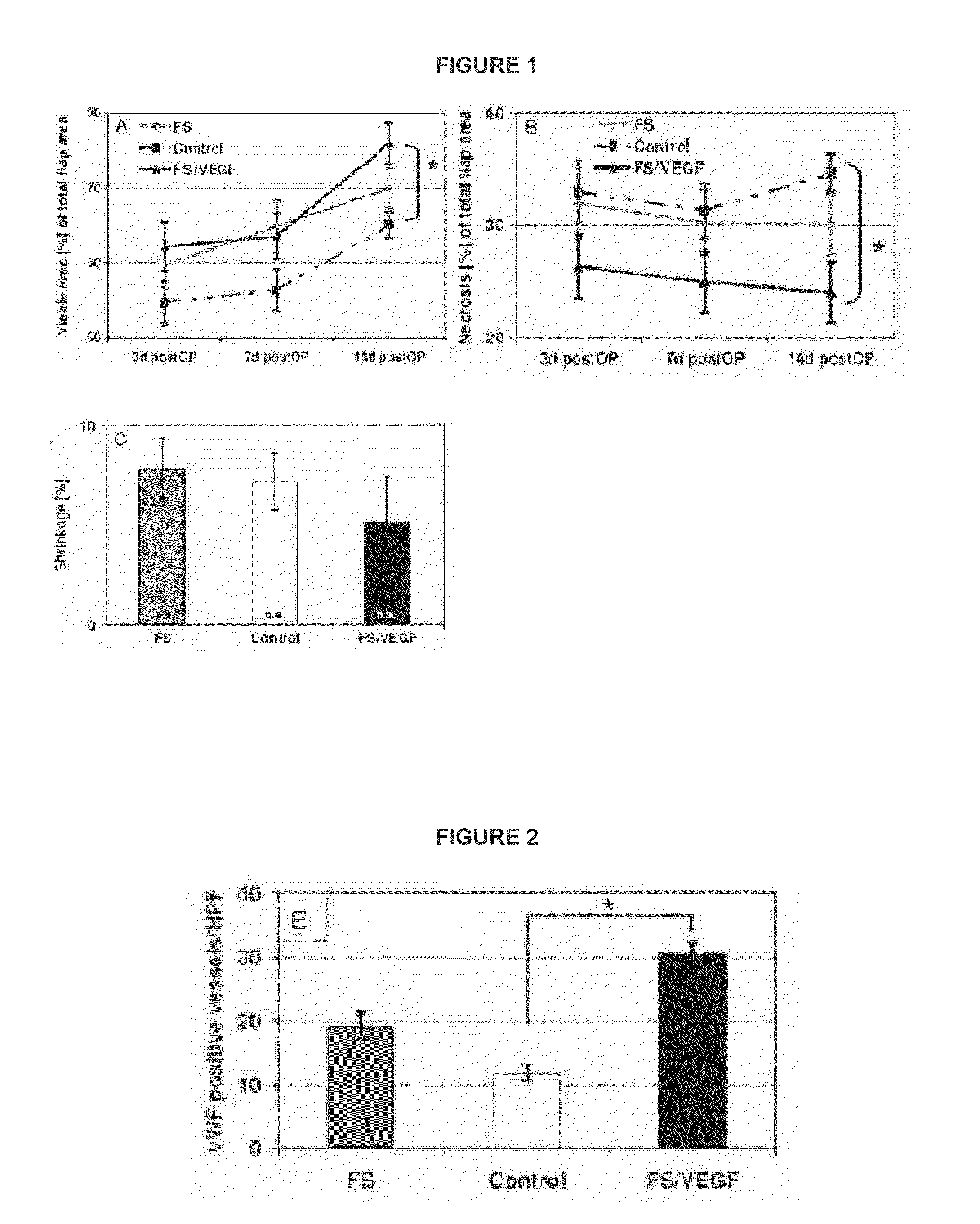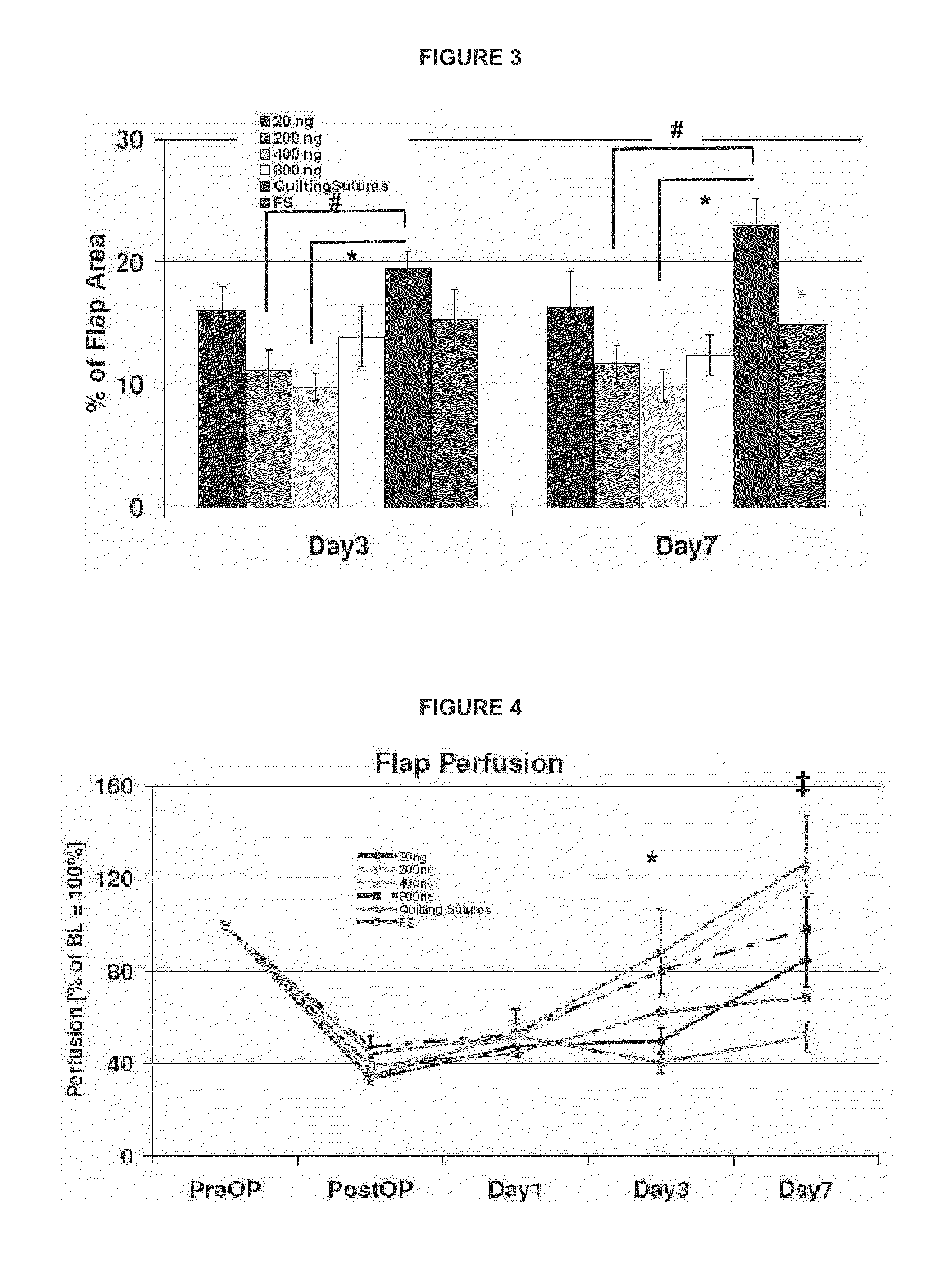VEGF165 Delivered by Fibrin Sealant to Reduce Tissue Necrosis
- Summary
- Abstract
- Description
- Claims
- Application Information
AI Technical Summary
Benefits of technology
Problems solved by technology
Method used
Image
Examples
example 1
[0041]In this study we evaluated the efficacy of FS spiked with VEGF165 to stimulate blood vessel growth and to reduce tissue necrosis in a dorsal flap rat model.
[0042]Thirty healthy Sprague Dawley rats (n=10 / group), weighing between 350 and 450 g, were caged individually in stainless steel cages in open housing conditions at a mean room temperature of 18±2° C. with water ad libitum and free dietary access. Each rat was box-induced using Isoflurane and maintained under anesthesia using ketamine (60 mg / kg, IM) and xylazine (16 mg / kg, IM). Fluid substitution was performed by subcutaneous injection of Ringer's solution (1 ml / hour). Following induction of general anesthesia, the back of each animal was shaved and depilated. The animal's rectal temperature was measured and maintained between 36.0 and 38.0° C. throughout the surgery. A rectangular dorsal myocutaneous flap (approximately 10×3 cm2) was harvested from cranially to caudally by blunt dissection and remained attached along the ...
example 2
[0052]In this study we investigated local sprayed fibrin sealant supplemented with VEGF165 at various concentrations on tissue necrosis in a rodent epigastric flap model. The efficacy to reduce tissue necrosis was observed over a 1 week period by digital photography and data were evaluated by a planimetric evaluation software tool. Furthermore, the influence of locally delivered VEGF165 from FS on superficial flap perfusion was tested using laser Doppler imaging.
[0053]This was a prospective, controlled, randomized, pre-clinical study. To test efficacy of FS supplemented with ascending concentrations of VEGF isoforms 165, epigastric fasciomyocutaneous flaps were harvested and treated with local sprayed FS ±VEGF165 on the recipient site. Four dosages of VEGF165 were tested (=test items): 20 ng / ml final FS clot, 200 ng / ml final FS clot, 400 ng / ml final FS clot, and 800 ng / ml final FS clot. FS without any VEGF165 served as the reference item.
[0054]Test Items:
[0055]A. Sprayed FS (TISSEEL...
example 3
(rh)VEGF165 Release from an In Vitro Fibrin Matrix
[0064]The 2.0 ml two-component FS Tisseel VH® (Baxter AG, Austria) was used in this study. The Sealer Protein component (Fibrinogen 75-115 mg / ml) was reconstituted with fibrinolysis inhibitor solution (Aprotinin 3,000 KIU / ml) and spiked with (200 ng / ml). The Thrombin component (500 IU / ml) was reconstituted with CaCl2 (40 μmol / ml) and diluted to 4 IU / ml.(18) Five fibrin matrices were made by mixing 75 μl of the Sealer Protein and (rh)VEGF165 solution with 75 μl of the thrombin component at 37° C. The resulting 150 μl fibrin matrix contained 200 ng / ml of (rh)VEGF165. Each fibrin matrix was individually covered with 1 ml of PBS with Aprotinin at 500 IU / ml and incubated at 37° C. on a shaking plate. At 1, 24, 46, 88 and 97 hours, the supernatant was collected, and fresh PBS and aprotinin was added. At 97 hours, fibrin matrices were lysed with trypsin to determine residual (rh)VEGF165 content of the fibrin matrix. (rh)VEGF165 was measured...
PUM
| Property | Measurement | Unit |
|---|---|---|
| Concentration | aaaaa | aaaaa |
| Concentration | aaaaa | aaaaa |
| Concentration | aaaaa | aaaaa |
Abstract
Description
Claims
Application Information
 Login to View More
Login to View More - R&D
- Intellectual Property
- Life Sciences
- Materials
- Tech Scout
- Unparalleled Data Quality
- Higher Quality Content
- 60% Fewer Hallucinations
Browse by: Latest US Patents, China's latest patents, Technical Efficacy Thesaurus, Application Domain, Technology Topic, Popular Technical Reports.
© 2025 PatSnap. All rights reserved.Legal|Privacy policy|Modern Slavery Act Transparency Statement|Sitemap|About US| Contact US: help@patsnap.com


